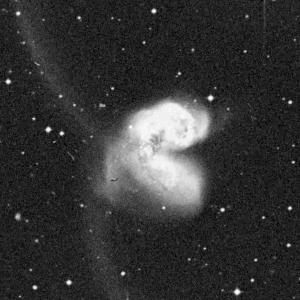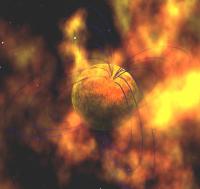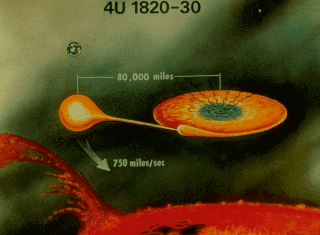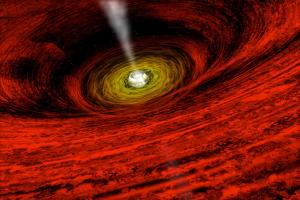

| |
The Antennae galaxy is actually two galaxies in the process of colliding.
| |
|
My research interests so far have ranged over the following areas:
- Cosmology, Galaxy formation, evolution and mergers,
- Properties of materials and the vacuum in ultrastrong magnetic fields,
- Physics of neutron stars,
- Magnetic and relativistic stellar structure,
- General relativity.
Presently my research is mostly focussed on the last three bullets.
The theme running though my work is how how is our understanding of
astrophysical phenomena connected with our understanding of
fundamental physics. Although my work so far has emphasized compact
objects (white dwarfs, neutron stars and black holes), the physics of
the early universe and cosmology in general also provides a window
onto fundamental physics.
I have compiled an archive of press clippings
and presentations about my work to complement the
information in my bibliography.
Magnetars


| |
An artist's Rendering of a Magnetar from NASA
| |
|
Taken to the extreme, the magnetic fields surrounding a neutron star can range from
108 to 1015 Gauss (the magnetic field at the surface of the Earth
averages 0.6 Gauss). At the high end of this range lie the magnetars whose fields
exceed the quantum-electrodynamic critical value of 4.4 x 1013 G. In such
strong fields, the typical energy of an electron spiral around a magnetic field line
exceeds its restmass energy.
The study of isolated cooling neutron stars continues to be a mainstay
of my research program. I have developed both analytic and numerical
models of the cooling of neutron stars including the effects of a
strong magnetic field, and Don Lloyd, Lars Hernquist and I are
currently developing the most comprehensive models of neutron star
atmospheres. The radiation from the surface of a neutron star
provides a excellent probe of the properties of atoms and light in
strong magnetic fields.
Nir Shaviv and I have discovered a series of signatures of the quantum
electrodynamic (QED) coupling of the radiation from the surface of a
neutron star to the magnetic field surrounding it. The most important
result is that QED-induced birefringence increases the observed
polarization of the radiation from the surface of a neutron stars by
about an order of magnitude. Optical polarimetry of nearby neutron
stars on existing telescopes would be able to detect this increase,
and X-ray polarimetry on the next generation of X-ray satellites could
probe this effect on a wider variety of sources and in greater detail.
The combination of optical and X-ray polarimetry would constrain the
radius of the neutron star, and the strength and structure of the
magnetic field surrounding it.
Millisecond Pulsars and LMXBs


| |
An artist's rendering of the LMXB 4U 1820-30 from NASA
| |
|
Weakly magnetized neutron stars usually reveal themselves as
millisecond pulsars. These quickly rotating stars are thought to form
when an ordinary neutron star accretes material from a low mass
companion in a low-mass x-ray binary (LMXB). The neutron star is spun
up by the accreting material. It is still unclear how the neutron
stars lose their magnetic fields as they are spun up.
Soon after the launch of RXTE, highly periodic oscillations were
discovered in Type-I X-ray bursts, in which the fuel accumulated on
the surface of a neutron star in an LMXB suddenly ignites and the flux
of the star increases by several orders of magnitude for several
seconds. The burning is thought to originate a particular point on
the surface and quickly spread over the surface. Initially the
oscillations were thought to be a signature of the hotspot as the star
rotates. The frequency of the oscillation changes slightly during the
burst which was thought to be due to the conservation of the angular
momentum in the shearing atmosphere. I showed that if this is indeed
the case, the evolution of the frequency of the oscillation coupled
with a knowledge of the expansion and contraction of the atmosphere
during the burst would provide a sensitive probe of general
relativity. Relativistic corrections reduce the observed frequency
shift by a factor or two to three relative to a Newtonian prediction.
Further study of the expansion of the atmosphere coupled with
relativistic kinematics have indicated that conservation of angular
momentum cannot account for the frequency shift observed in these
sources. I have recently proposed that the observed oscillations are
a hallmark of large-scale waves traveling through the cooling ocean
during the decay of the burst. These waves have well understood
analogues in oceans of the Earth, especially in the Pacific basin, and a
straightforward scaling of their properties on the Earth to the
condition on the surface of a neutron star accounts for the observed
frequency shift and may provide deeper insight into nuclear burning of
the surface of neutron stars.
In the same vein, Ramesh Narayan and I have been developing
steady-state numerical and semianalytic models to understand the
evolution of the accumulating atmosphere on the surface of a compact
object up to the onset of the nuclear burning instability, i.e. the
Type-I burst itself. This model predicts the regime of accretion
rates and neutron star properties which allow stable nuclear burning
on the surface of the star, i.e. no bursts. Furthermore, unlike fully
time-dependent simulations of Type-I bursts, we can explore a wide
range of neutron star parameters and physical assumptions to gain a
broad understanding of X-ray novae in general.
Black Holes


| |
An artist's rendering of a black hole accretion disk from CXC/NASA/SAO.
| |
|
My research into the physics of black holes like the kinematics of
Type-I burst oscillations began not with the observations but with
trying to understand the hallmarks of spacetime symmetries in general
relativity. In the case of the black holes, I developed a model of a
charged-starved magnetosphere of a spinning black hole. If a magnetic
field with the strength typical of a radio pulsar threads a spinning
stellar black hole, the result is a jet of highly energetic electrons
and positrons with an initial luminosity exceeding 1051 ergs/s.
The production of pairs results from the quantum electrodynamic
treatment of the electromagnetic field surrounding the hole (i.e. the
Wald field). Whether this could provide the engine for a
gamma-ray burst depends on whether the magnetosphere remains starved
of charge and if it does not on what are the properties of the
magnetosphere. This second important aspect of the problem is a focus
of my current research.
Compact objects provide a laboratory to verify our understanding of
nature at the extreme. The intense magnetic fields of neutron stars
dwarf those produced on Earth a billion-fold, and the densities and
pressures exceed the realm of Earth-bound experiment by a factor of a
trillion or more. Neutron stars provide a unique opportunity to
extrapolate and verify our theories of matter, energy and their
interaction. Understanding black holes and their interaction with
their surroundings also probes our understanding materials under
extreme conditions; however, more crucially black holes test our
understanding of spacetime itself. My research over the past few
years has focussed of the theoretical and observational understanding
of these objects.
General Theme

A general theme threads my research interests: how is our
understanding of astrophysical phenomena connected with our
understanding of fundamental physics. The gross properties of neutron
stars such as their mass and radius which we might learn definitively
from observations of the thermal radiation from their surfaces, probes
nuclear physics in an otherwise inaccessible realm. The details of
their kinematics may probe the quark-gluon phase transition, and the
understanding the dynamics of material and light near their surfaces
can verify QED and general relativity. The dynamics of black holes, the
matter and fields surrounding them most directly probes general relativity,
but perhaps also QED in the context of the central engine of gamma-ray
bursts. I intend to continue my research in the exciting area of the
physics of compact objects.
Starting in the distant past and proceeding to the present and from
large scales to small, some of the questions that I would like to
address in my future research:
-
What is the nature of the initial singularity? Is it necessary?
-
Can generic principles help constrain the properties of dark energy in
the distant past and today?
-
How does varying dark energy affect structure formation?
Now jumping down twenty orders of magnitude...
-
Does QED play a role in producing or processing the radiation from
soft-gamma repeaters? In classical gamma-ray bursts?
-
What is the composition of neutron-star atmospheres (ionized, atomic
or molecular)? What can we learn from their spectra?
-
How can geophysical analogues help us understand neutron-star phenomena?
-
What is the nature of nuclear matter in the core of a neutron star?
Is the quark-hadron phase transition important in neutron-star cores?
What can observations of neutron stars tell us about quantum
chromodynamics?
-
What is the nature of neutron-star collapse? Does it have any
important observable consequences?
-
How can black-hole electrodynamics help explain the observations and
energetics of accreting black holes?
Jeremy Heyl
<heyl@physics.ubc.ca>
Last modified: 2005-04-06 10:33
www.digits.com counter : hits since 10 June 2003. hits since 10 June 2003.
|